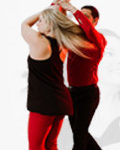When you’ve mastered hearing upbeats and downbeats in music, you are ready to bring that skill into your pattern work.
West coast swing is a two-beat dance, so all patterns are built on the downbeat-upbeat structure. If all you dance is basic, off-the-shelf WCS patterns, you don’t need to know that structure because the dance takes care of it for you. But, that’s not the dance that you’ll find on the floor today.
The reality is that today’s dance uses play, extensions, and movements from other dances a lot. When you leave the basic WCS patterns, you need to understand the language of downbeats and upbeats so you can sustain the dance.
Here are some examples of how downbeats and upbeats structure the dance:
- Play finishes on an upbeat so that “normal” WCS can resume on a downbeat
- Anchors start on a downbeat so the full two-beat anchor can finish a pattern
- Extensions start on a downbeat so the previous two-beat sequence of the pattern can finish
- Extensions finish on an upbeat so that the next two-beat sequence of the pattern can start on a downbeat
- Posting at the end of the slot happens on an upbeat so the two-beat anchor can start on the downbeat
The Drill: Dance a couple of songs, either with a partner or by yourself. As you dance, count your dance by downbeats and upbeats rather than numbers.
The goal of this exercise is to train yourself to recognize where downbeats and upbeats happen in patterns. Being able to recognize downbeats and upbeats quickly is the key to seamlessly switching from pure WCS to play or extensions and back into WCS. When you instinctively understand whether you are on an upbeat or a downbeat, you know whether it is appropriate to lead a non-pattern based movement or when your body is positioned to resume the normal dance.
[mediacredit inline=”FALSE”]




 Brian & Megan
Brian & Megan